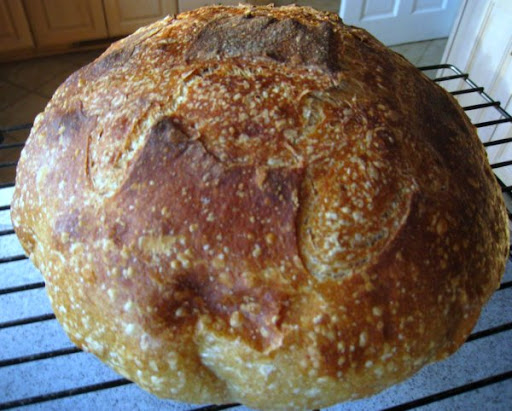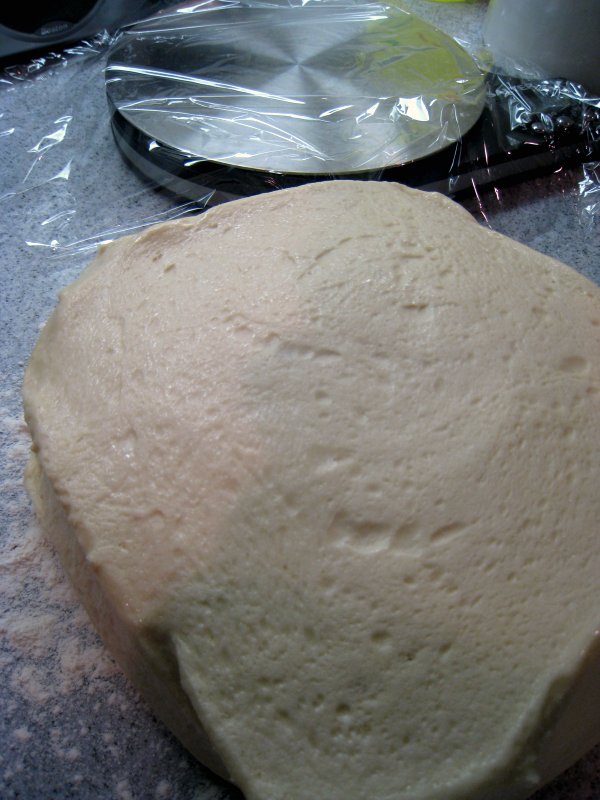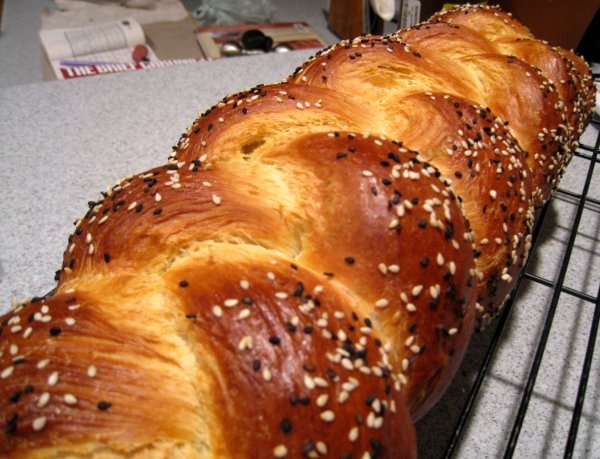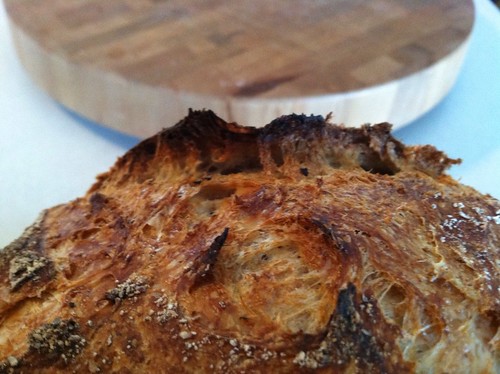Bread making
Bread making
-
-
-
-
-
-
Post #91 - February 7th, 2011, 3:46 pmBill/SFNM wrote:Scorching can have more to with ingredients than stone temp. Do you have any browning agents such as sugar or honey or milk in the dough? Also, the type of flour and the fermentation regimen play a role in the amount of natural sugars left in the dough after proofing.
Bill, thanks for your interest. This was a lean dough with no browning agents. It was the basic sourdough recipe from Bread Baker's Apprentice. I used 100% barm instead of a firm starter and I spiked it with wild yeast for a roughly 4.5 hour same day rise (punched down twice). Other than the barm, the ingredients were flour, water, yeast, and salt.
Given the fact I'd made this bread before without any similar issues (although I used a firm starter, no commercial yeast, and gave it an overnight rest), I figured these changes were unlikely to create the scorching issues I encountered and concluded this likely had more to do with temperature. If anyone knows better, however, I welcome your input.
-
-
Post #92 - March 6th, 2011, 11:05 am

scored the dough moments before baking. This is 50% WW and 50% white wheat
NYT no knead as a starting point...
-
-
-
Post #94 - April 3rd, 2011, 3:14 pmPerhaps a little late to the party, I too have been experimenting with the Tartine bread recipe listed here.
This is a flavorful no-knead style bread. I too have found it relatively forgiving in terms of exact proportions and timing as I have made some modifications in the 3 breads I have baked. I have used the 50/50 ratio levain between flour and water, splitting the flours between white and wheat and adding a tablespoon of starter from my inherited culture (instead of rolling your own as the recipe calls for). I find the recipe's tip that the levain should float in water before using to be very practical when you are trying to measure the development of your preferment. Thanks, Tartine!
I baked the first couple of breads more or less as directed. On the third, I upped the whole wheat content to 20% of the flour weight and also subbed another 15-20% King Arthur all purpose flour for the bread flour (KA is still a fairly high protein content AP flour and I had more of it on hand than I did bread flour).
I'm quite pleased with the results.
I followed Bill SFNM's suggestion to bulk ferment and then refrigerate, only to pull it out the next day and finish the shaping and rising. This mad it not only a more manageable process in terms hands on time, but also featured better flavor development.
I've fond that heating the dutch oven on a pizza stone helps to avoid some bottom crust scorching I was running into. I also
have been borrowing the parchment paper sling idea from the Cook's Illustrated no-knead 2.0 recipe. I spray parchment paper, line a bowl with it, and put the bread it right-side up to rise. When the time comes, I just lift out the bread by the parchment and drop it into the hot dutch oven. At this point, it's just too easy not to do it this way and I haven't seen any difference in the rise, shape, or quality of the bread.
The texture is typical to other no-knead breads I have tried: a very crisp outside with a soft and squishable center. I store the bread cut side down on my cutting board (the cutting board prevents staling on the cut side and the crust is side does not seem to stale very quickly) to maintain texture. I think it does firm up a little bit the next day which I have liked.
The extended rise time also helped the interior texture which was less dense and had more sizeable holes.
Here is a cross-section:
I look forward to continued experimentation with this bread.
-
-
Post #95 - April 4th, 2011, 6:16 pmgastro gnome wrote:I baked the first couple of breads more or less as directed. On the third, I upped the whole wheat content to 20% of the flour weight and also subbed another 15-20% King Arthur all purpose flour for the bread flour (KA is still a fairly high protein content AP flour and I had more of it on hand than I did bread flour).
That looks terrific!! You're motivating me to play around with the white/wheat ratio.
-
-
Post #96 - April 10th, 2011, 4:46 pm

no whole wheat in the house this AM so 100% white wheat from Costco
with the heat today, this was ready to bake super quick today
(meaning it had risen to it's usual level in the bowl I always use in less
than 8 hours!)
lots of oven pop (or whatever that is called)
slice shot in the morning when I make toast.
-
-
-
Post #98 - April 18th, 2011, 8:50 amgastro gnome wrote:More from a busy week of bread-making:
White sandwich loaf
Dough rising:
Risen dough:
Portioned dough:
Finished loaves (some cracking on the top of one):
Interior:
Whole wheat multi-grain boule (without any of that egg wash or fancy stuff)
This is probably the wheatiest tasting bread I've made to date. I put in coarse corn meal which didn't really soften in the overnight soaker so there's a grittiness to the crumb I don't love. But that can be fixed the next time I make it.
Challah
Braided for bench proofing:
After proofing and topped:
Finished bread:
A large loaf:
Because of the additions of egg and oil, this dough was extremely easy to work with. It was an all bread flour recipe, so forming gluten was fairly easy. The only tough part to this recipe was rolling out the three strands for braiding. Because of the high gluten content, the dough was not very extensible and sprang back to shape. I had to roll a bit and then let it rest a number of times until I had the length I was looking for. After that, though, the braiding and decoration was fairly simple. This was a crispier crust than I'm used to in challahs, but that was entirely welcome. I do think it might have been a little light on flavor, maybe some more salt. But overall, I was quite pleased. I will definitely make challah again.
Those are amazing if you don't mind to give me the recipe wanna try it please *_*
-
-
Post #99 - April 18th, 2011, 10:39 pmAnoody wrote:Those are amazing if you don't mind to give me the recipe wanna try it please *_*
These are all from Peter Reinhart's Bread Baker's Apprentice and Whole Grains Breads
-
-
Post #100 - April 18th, 2011, 10:41 pmmhill95149 wrote:could have used another 2 or 3 min in the oven

Looks good to me!
Then again anything would, and I'm only 5 hours into the week of the Bread of Affliction.
Question: Is there anything so unrewarding as making your own matzoh? Perhaps this weekend I will take one for the team and find out.
-
-
Post #101 - April 18th, 2011, 10:41 pmmhill95149 wrote:could have used another 2 or 3 min in the oven

Looks good to me!
Then again anything would, and I'm only 5 hours into the week of the Bread of Affliction.
Question: Is there anything so unrewarding as making your own matzoh? Perhaps this weekend I will take one for the team and find out.
-
-
Post #102 - April 22nd, 2011, 4:50 pmsame old same old..

though the second rise was 4.5 hours and the nice shaped loaf I had
had puddle under the dome I cover the dough with.
re-shaped and let rest for 30 min and all was well.
lots of oven spring (if that is the correct term??)
-
-
Post #103 - May 6th, 2011, 11:03 am

shorter second rise after a night in the 'fridge
re-formed loaf and scored the top and into the oven
no rest post forming
-
-
-
Post #105 - March 5th, 2012, 11:44 amI just scored the long loaf proofing basket/banneton/brotform that I'd been looking for on ebay for about half of the Amazon price, and it looks like the seller has a few more:
Check it out here....
Shipping and handling included, too!“Assuredly it is a great accomplishment to be a novelist, but it is no mediocre glory to be a cook.” -- Alexandre Dumas
"I give you Chicago. It is no London and Harvard. It is not Paris and buttermilk. It is American in every chitling and sparerib. It is alive from tail to snout." -- H.L. Mencken
-
-
Post #106 - March 5th, 2012, 12:27 pmThat is a great price
-
-
Post #107 - March 12th, 2012, 12:17 pm

645 grams flour 50% whole wheat
525 grams water
12 grams salt
1.5 grams dry active yeast
18 hour first rise
three hour second rise
baked in a large dutch oven at 450˚ for 30 min with the lid on then 15 min lid off.
-
-
-
-
Post #110 - March 23rd, 2019, 7:22 amA really great bread baking class at the French Pastry School (part of their "enthusiast" program) has inspired a big bread making kick for me recently. I've been trying to bake every week or so. Some recent favorites are a seeded sourdough loaf (oats, flax seed, sesame seeds, pumpkin seeds and sunflower seeds) and a honey whole wheat sour dough. I feel like I'm getting better but I've still got a lot to learn--my scoring technique, in particular, needs some work (if anyone has tips, feel free to offer 'em up here).
-
-
Post #111 - March 23rd, 2019, 4:15 pmIf you are into Facebook Groups you might be interested in this one related to yeasted bread baking - you have to request to join it
https://www.facebook.com/groups/460176410989681/Leek
SAVING ONE DOG may not change the world,
but it CHANGES THE WORLD for that one dog.
American Brittany Rescue always needs foster homes. Please think about helping that one dog. http://www.americanbrittanyrescue.org
-
-
Post #112 - March 23rd, 2019, 6:33 pmleek wrote:If you are into Facebook Groups you might be interested in this one related to yeasted bread baking - you have to request to join it
https://www.facebook.com/groups/460176410989681/
Great group. They do both wild yeast and commercial yeast.
Also come to the Chicago Bread Club on Monday if you are available.Ava-"If you get down and out, just get in the kitchen and bake a cake."- Jean Strickland
Horto In Urbs- Falling in love with Urban Vegetable Gardening
-
-
Post #113 - March 24th, 2019, 7:13 amleek wrote:If you are into Facebook Groups you might be interested in this one related to yeasted bread baking - you have to request to join it
https://www.facebook.com/groups/460176410989681/
Great group. They do both wild yeast and commercial yeast.
Also come to the Chicago Bread Club on Monday if you are available.
Thanks for these suggestions--these are great.
I found Chicago Bread Club instagram page so I'm going to try and get there (or come in April!!
Thanks, Becca
-
-
Post #114 - March 28th, 2019, 8:33 amI found this article and I simply find the concept of home bread deliveries charming.
The pic has nothing to do with the article. Just bread I made earlier this week.Ava-"If you get down and out, just get in the kitchen and bake a cake."- Jean Strickland
Horto In Urbs- Falling in love with Urban Vegetable Gardening








